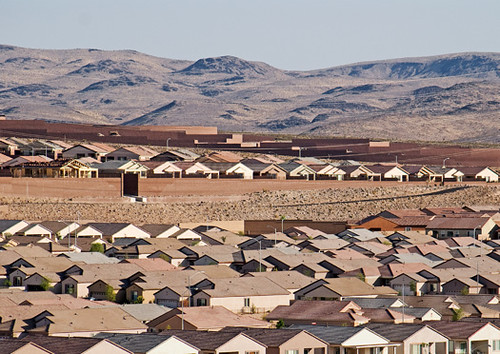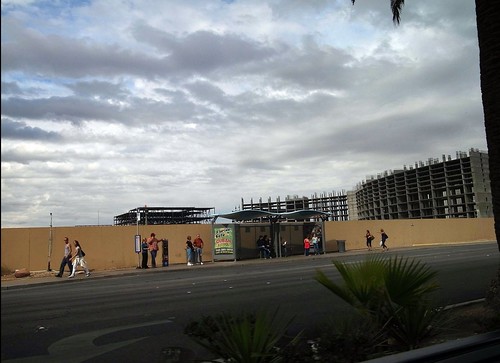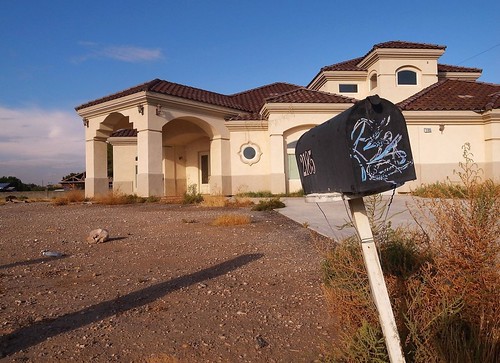Leaving Las Vegas: facts and images from the desert mega-bust

Posted November 9, 2010 at 1:21PM
Las Vegas, a sprawling neo-city illogically built in a desert, is the largest per-capita consumer of water in the United States, sucking up 343 gallons per person per day, or 70 percent more than the rate for Los Angeles, according to a report from last year. The area gets 88 percent of its water from Lake Mead, whose levels have dropped 132 feet in the last decade, reaching an all-time low just last month.
Yet until recently Las Vegas was also the fastest-growing metropolitan area in the country, expanding ever-outward in the 1990s and early 2000s with more and more homes and commercial buildings, many built on speculation. In 2005, there were 20 residential development projects of more than 300 acres each under construction. The regional population nearly tripled between 1990 and 2010.
But that was then. Today the boom days are gone, possibly forever. The satellite images of unfinished developments on the area’s fringe, above and below, were taken at the end of May of this year.
According to a story written by Tony Illia in the Las Vegas Business Press earlier this year, construction unemployment in Nevada has hovered around 30 percent statewide. The industry – which previously accounted for 21 percent of the state’s gross domestic product – has lost 81,900 jobs, or 55 percent of its work force, during the last four years.
Meanwhile, Nevada has ranked first in the country in foreclosure filings since 2007, reports Buck Wargo in the Las Vegas Sun. The median price of an existing home in Las Vegas has fallen nearly 60 percent since 2006, and the median price of a new home has fallen almost as much.
The bust has been felt just as much in the commercial real estate market as in housing, says Wargo:
“The office market grew from 28.4 million square feet in 2000 to 48.5 million square feet in 2008. Since then, the market has added only 1.2 million square feet. That’s because the vacancy rate that was 7.7 percent in 2000 stands at 23.4 percent this year with 11.6 million square feet of vacant space, according to Applied Analysis.”
From the magical escapist neon of The Strip to the development roller-coaster of the last decade to the sheer improbability of it all, Las Vegas has long attracted the attention of photographers and scholars, notably including sharp images and insight from German architects Nicole Huber and Ralph Stern. That’s a photo from their 2008 book Urbanizing the Mojave Desert just above, and you can view more, along with some of their eloquent commentary, in an essay here. Their words:
"Las Vegas contains many landscapes of failure, where the spatial and physical manifestations of earlier social, cultural, and economic practices have been swept aside by newer practices without regard to the loss of memory and identity, or to the disruption of viable social and cultural networks. Landmark resorts of the 1950s and 1960s — the Frontier, Dunes and Stardust — have vanished. The long-neglected Moulin Rouge — constructed in 1955, and celebrated as the first desegregated casino — was torn down in May 2009. The Las Vegas celebrated by Robert Venturi and Denise Scott Brown, and mythologized by the Rat Pack, Howard Hughes and Elvis Presley, can now only be eulogized . . .
"Las Vegas finds itself at a remarkable historical juncture. Long touted as recession-proof, the city is struggling not only with plunging real estate values but also with double-digit unemployment, record deficits and loss of self-confidence. In 2007 tourism, a mainstay of the economy, boasted a record 39.2 million visitors. Since then McCarran International Airport has seen 19 consecutive months of passenger decline. Michelin will not be producing a 2010 guide for Las Vegas. Even more striking is that after ten consecutive years of annual population gains, averaging more than 60,000, Clark County declined last year by 10,000. Since 2008, more than 4,000 adults leave the Las Vegas Valley every month. And all the while the water level of Lake Mead continues to drop."
(On the subject of the region's ability to attract the attention of artists and thinkers, I also highly recommend the underappreciated 1980 Francis Ford Coppola film One From the Heart. It is a love story having nothing to do with the usual subjects of this blog, but a personal favorite with incredible visuals of a highly stylized fantasy-Vegas. It also features a wonderful soundtrack by Tom Waits and Crystal Gayle.)
More recently, the effects of the mega-bust have been powerfully captured by photographers Spencer Platt and Ethan Miller, and posted last month by Ryan McCarthy on Huffington Post. Here’s a small sample:
Go here for the full, large-format slideshow. This, says McCarthy, is today’s Las Vegas.
I honestly don't know how I feel about this. On the one hand, unsustainability is being proven in a very literal sense, bringing lessons more convincing than any environmentalists' words; our prophecies about sprawl are being borne out and, as a trend, that's a good thing. Even so, however, I find it very hard to take pleasure in the death of dreams.
I leave you with Sheryl Crow’s classic, as performed last year on Elvis Costello’s wonderful TV show:
Move your cursor over the images for credit information.




